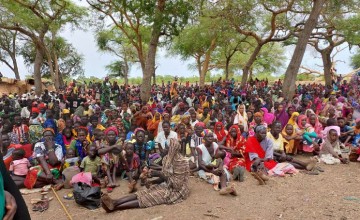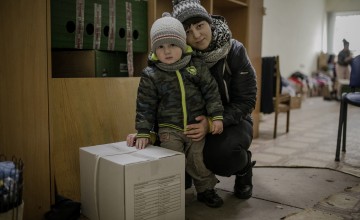
Read our 2023 annual report

Knowledge Hub
Refugees often make the headlines for sensationalist, fear mongering reasons, but every refugee is a human being with a real story.
A small but vocal minority of people in Ireland pin the blame on the refugee population for issues like the housing crisis, cuts in resources, or a lack of jobs - or even for violent incidents and crimes. Some people also make inflammatory comments about the number of men amongst the small refugee population in Ireland, and doubt their reasons for being here.
Millions of people worldwide have been forcibly displaced as a result of conflict, persecution and human rights violations, and seek safety in another country. Millions more have been forced to uproot their lives due to climate change wreaking havoc on their homes. Even millions more have risked a treacherous journey to create a better life for themselves and their families.
As of mid-2023, 110 million people worldwide have been forcibly displaced as a result of conflict, persecution and human rights violations. 62.5 million of whom are internally displaced people, 36.4 million of them are refugees, and an additional 6.1 million are asylum seekers.
Here, we explain why somebody would risk it all to make a journey for a better life, and dispel myths and unhelpful narratives around refugees.

Refugees vs IDPs vs asylum seekers vs migrants
Who is a refugee?
A refugee is a person who flees their home, crosses an international border, and cannot return home as they believe their life is in danger. They could be fleeing armed conflict, or persecution based on their race, religion, gender, sexuality, nationality, or politics. For example, 1.8 million people have fled Sudan due to ongoing conflict into countries including Chad and South Sudan.
Refugees are protected by the Universal Declaration of Human Rights, which states, in article 14, that everyone has the right to seek asylum from persecution in other countries; and the 1951 UN Refugee Convention, which protects refugees from being returned to countries where they risk being persecuted.
Who is an internally displaced person?
If a person is displaced from their home, but does not cross an international border, they are considered an IDP, or internally displaced person. For example, in addition to the 5.1 million people who have fled Ukraine due to conflict, there is an additional 3.7 million people who have been displaced within Ukraine. And in Gaza, it’s estimated that around 1.7 million people have been internally displaced.
Who is an asylum seeker?
An asylum seeker is someone who has crossed an international border and claims to be a refugee, but has not been recognised as such yet. Within the European Union, current policy dictates that asylum seekers must apply for protection in the first EU country that they enter, and they receive refugee status once a positive decision has been made by national authorities. Not every asylum seeker will be recognised as a refugee, but every refugee begins as an asylum seeker. Asylum seekers are currently in the news in Ireland due to International Protection applicants living in tents in Dublin as they await shelter.

Who is a migrant?
Migrants are often lumped in with refugees in the media, and there is some confusion about the distinction between the two groups. While there is not one universally accepted definition, migrants move not usually because of persecution, but to improve their life by seeking work, education, or better living conditions, or reuniting with family. Often, they have very little choice but to move, or face poverty and chronic hunger. For example, millions of Irish people have migrated to the US since the 1820s, pushed out by poverty and seeking a better life and better work opportunities.
The 1990 Migrant Workers Convention offers protection for migrants and their families.
Where have refugees fled from, and where are they going?
Around half of all refugees come from three countries - Syria (6.5 million), Afghanistan (6.1 million) and Ukraine (5.1 million).
Iran and Türkiye each host 3.4 million refugees - the largest populations worldwide. Germany and Colombia host 2.5 million refugees, while Pakistan has a refugee population of 2.1 million. 69% of refugees and other people in need of international protection live in countries neighbouring their countries of origin, and 75% of all refugees are hosted by low and middle income countries.
In comparison, as of November 2023, Ireland was hosting just over 100,000 people seeking asylum, the majority of whom had come from Ukraine.
“Why are so many refugees men?”
The topic of immigration and refugees is pervasive online, and Concern’s comments section is no different. Often, on an image we post of a woman and children who are refugees, a minority will complain that this isn’t representative of the population of refugees, and claim that the only refugees they see in Ireland are “fighting age” men who have abandoned their families in war zones.
However, these claims are not only misguided, they’re harmful.
According to the Refugee Council, around 48% of the 110 million people who are forcibly displaced worldwide are women. 43.3 million of them are children, and 1.9 million children were born as refugees. So, women and children are a majority amongst the displaced. But it is true that most of the refugees that initially reach Europe are men.
This is because of a number of different factors - that all make perfect sense when you think about it.
Travelling for asylum can be dangerous
Travelling for asylum is a dangerous journey, but sometimes, it’s a family’s only choice. As British-Somali poet Warsan Shire said in her poem "Home": “You have to understand that no one would put their children in a boat unless the sea is safer than the land."
However, a safe and successful journey is tragically not a sure thing. According to the International Organisation for Migration's Missing Migrants Project, an estimated 63,000 deaths and disappearances of migrants were recorded over a 10-year period, with 27,000 deaths attributed to drowning in the Mediterranean alone. In 2023 alone, over 8,500 deaths were recorded.
Due to the danger and uncertainty, men often choose to make the journey to Europe alone so they can apply for asylum, and their family can reunite with them via a safer route at a later date.
You have to understand that no one would put their children in a boat unless the sea is safer than the land.
Women and children are less likely to survive the journey
The IOM report confirms that out of the identified deaths of migrants over the past decade, 5,500 women died on migration routes and 3,500 children died. However, over 37,000 recorded deaths do not have information available on gender or age, so the true number of deaths of women and children is believed to be much higher.
Asylum seekers often travel via risky routes across the Mediterranean Sea, or in the back of refrigerated lorries where suffocation and hypothermia can be a major risk; in 2019, the bodies of 39 Vietnamese people were found in the back of a lorry in Essex, having been loaded in Belgium. Young, able-bodied men are more likely to survive boat accidents or other accidents and tragedies, so assume the risk to protect their families.
Women and children are more likely to be exploited en route
According to the UN, women and children are at high risk of sexual abuse, violence and exploitation while travelling from a war zone to safety. This can happen at any point of an unsafe route, which increases the risk of gender-based violence, including human trafficking. Many men choose to take an unsafe route so their female family members can take a safer route later on and avoid potential violence and exploitation.

It can be hard for a family to stay together
Think about how difficult it is to keep a group of friends or family together moving between venues on a holiday in a country you don’t know. It is monumentally more difficult, logistically, to keep a family safely together on a long, treacherous journey. People can be separated; elderly or young relatives can need extra help or move at a slower pace; somebody may become sick or get injured. It makes sense to assume less responsibility when taking an already stressful and fraught journey.
Single men have the right to seek asylum too
Many male asylum seekers will be joined by families at a later date, but some men are seeking asylum alone. There is no prerequisite for marriage or children to seek asylum. Everyone has the right to seek refuge when their lives are endangered, be they men, women or children. Men cannot be excluded from human rights based on their gender alone - nobody can. These rights are universal.
Men are often dehumanised in humanitarian contexts, with women and children prioritised in reporting casualties and humanitarian need. But male lives are equally important, and men face persecution and violence too. They deserve to seek safety as much as anybody else.

Concern's work with refugees
The Comprehensive Refugee Response Framework was adopted by all 193 Member States of the United Nations in September 2016, and calls for greater support to refugees and the countries that host them. Concern’s work incorporates many of the aims and principles of the framework, as many of the countries we work in face displacement crises or host refugees from neighbouring countries.
Last year alone, Concern responded to 66 emergencies in 23 countries, reaching 17.8 million people with urgent necessities such as shelter, psychosocial support, healthcare, and food as well as longer-term livelihoods training that benefit both displaced and host communities.
Among the largest displacement crises we are responding to are the Democratic Republic of Congo, where 6.8 million people are internally displaced, and Sudan, where 10 million people have been forced from their homes. We are supporting Sudanese refugees who have fled conflict to Chad with the provision of shelter, support of health centres and mobile health clinics, and the distribution of NFI (non-food item) kits including blankets, tarpaulins, cooking utensils and jerry cans. We also work with internally displaced people within Ukraine, providing families with cash transfers so they can winterise their homes and providing grants to get small businesses back on their feet.





